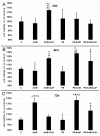Impact of Antibiotics on the Proliferation and Differentiation of Human Adipose-Derived Mesenchymal Stem Cells
- PMID: 29186789
- PMCID: PMC5751125
- DOI: 10.3390/ijms18122522
Impact of Antibiotics on the Proliferation and Differentiation of Human Adipose-Derived Mesenchymal Stem Cells
Abstract
Adipose tissue is a promising source of mesenchymal stem cells. Their potential to differentiate and regenerate other types of tissues may be affected by several factors. This may be due to in vitro cell-culture conditions, especially the supplementation with antibiotics. The aim of our study was to evaluate the effects of a penicillin-streptomycin mixture (PS), amphotericin B (AmB), a complex of AmB with copper (II) ions (AmB-Cu2+) and various combinations of these antibiotics on the proliferation and differentiation of adipose-derived stem cells in vitro. Normal human adipose-derived stem cells (ADSC, Lonza) were routinely maintained in a Dulbecco's Modified Eagle Medium (DMEM) that was either supplemented with selected antibiotics or without antibiotics. The ADSC that were used for the experiment were at the second passage. The effect of antibiotics on proliferation was analyzed using the 3-[4,5-dimethylthiazol-2-yl]-2,5-diphenyltetrazolium bromide (MTT) and sulforhodamine-B (SRB) tests. Differentiation was evaluated based on Alizarin Red staining, Oil Red O staining and determination of the expression of ADSC, osteoblast and adipocyte markers by real-time RT-qPCR. The obtained results indicate that the influence of antibiotics on adipose-derived stem cells depends on the duration of exposure and on the combination of applied compounds. We show that antibiotics alter the proliferation of cells and also promote natural osteogenesis, and adipogenesis, and that this effect is also noticeable in stimulated osteogenesis.
Keywords: adipose-derived stem cells; amphotericin B; copper (II) ions; osteogenesis; penicillin; streptomycin.
Conflict of interest statement
The authors declare no conflicts of interest.
Figures











Similar articles
-
Osteogenic differentiation of rat mesenchymal stem cells from adipose tissue in comparison with bone marrow mesenchymal stem cells: melatonin as a differentiation factor.Iran Biomed J. 2008 Jul;12(3):133-41. Iran Biomed J. 2008. PMID: 18762816
-
Adipose-derived mesenchymal stromal (stem) cells differentiate to osteoblast and chondroblast lineages upon incubation with conditioned media from dental pulp stem cell-derived osteoblasts and auricle cartilage chondrocytes.J Biol Regul Homeost Agents. 2016 Jan-Mar;30(1):111-22. J Biol Regul Homeost Agents. 2016. PMID: 27049081
-
Activation of Sirt1 decreases adipocyte formation during osteoblast differentiation of mesenchymal stem cells.J Bone Miner Res. 2006 Jul;21(7):993-1002. doi: 10.1359/jbmr.060415. J Bone Miner Res. 2006. PMID: 16813520
-
Defining adipose tissue-derived stem cells in tissue and in culture.Histol Histopathol. 2010 Jun;25(6):807-15. doi: 10.14670/HH-25.807. Histol Histopathol. 2010. PMID: 20376787 Review.
-
Concise Review; Effects of Antibiotics and Antimycotics on the Biological Properties of Human Pluripotent and Multipotent Stem Cells.Curr Stem Cell Res Ther. 2021;16(4):400-405. doi: 10.2174/1574888X16999201203214425. Curr Stem Cell Res Ther. 2021. PMID: 33272189 Review.
Cited by
-
Spheroid trilineage differentiation model of primary mesenchymal stem/stromal cells under hypoxia and serum-free culture conditions.Front Bioeng Biotechnol. 2024 Jul 31;12:1444363. doi: 10.3389/fbioe.2024.1444363. eCollection 2024. Front Bioeng Biotechnol. 2024. PMID: 39144480 Free PMC article.
-
Mesenchymal Stem Cells and Exosomes: A Novel Therapeutic Approach for Corneal Diseases.Int J Mol Sci. 2023 Jun 30;24(13):10917. doi: 10.3390/ijms241310917. Int J Mol Sci. 2023. PMID: 37446091 Free PMC article. Review.
-
Applying Vasopressin-Pre-Conditioned Human Adipose Mesenchymal Stem Cells Improves Heart Condition after Transplantation into Infarcted Myocardium.Int J Mol Cell Med. 2022;11(3):207-222. doi: 10.22088/IJMCM.BUMS.11.3.207. Int J Mol Cell Med. 2022. PMID: 37605740 Free PMC article.
-
Reactions of cisplatin and oxaliplatin with penicillin G: implications for drug inactivation and biological activity.J Biol Inorg Chem. 2022 Dec;27(8):695-704. doi: 10.1007/s00775-022-01958-z. Epub 2022 Sep 25. J Biol Inorg Chem. 2022. PMID: 36153767 Free PMC article.
-
Osteogenesis of adipose-derived stem cells from patients with glucose metabolism disorders.Mol Med. 2020 Jul 2;26(1):67. doi: 10.1186/s10020-020-00192-0. Mol Med. 2020. PMID: 32615920 Free PMC article.
References
-
- Cieslar-Pobuda A., Knoflach V., Ringh M.V., Stark J., Likus W., Siemianowicz K., Ghavami S., Hudecki A., Green J.L., Los M.J. Transdifferentiation and reprogramming: Overview of the processes, their similarities and differences. Biochim. Biophys. Acta. 2017;1864:1359–1369. doi: 10.1016/j.bbamcr.2017.04.017. - DOI - PubMed
-
- Baglioni S., Francalanci M., Squecco R., Lombardi A., Cantini G., Angeli R., Gelmini S., Guasti D., Benvenuti S., Annunziato F., et al. Characterization of human adult stem-cell populations isolated from visceral and subcutaneous adipose tissue. FASEB J. 2009;23:3494–3505. doi: 10.1096/fj.08-126946. - DOI - PubMed
MeSH terms
Substances
LinkOut - more resources
Full Text Sources
Other Literature Sources
Medical

